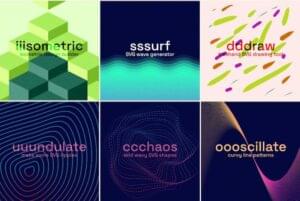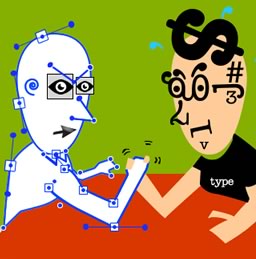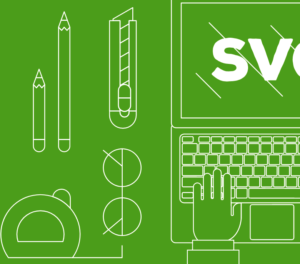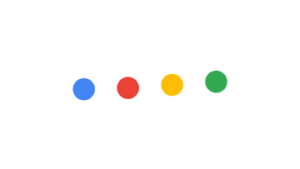What is SVG?
SVG (Scalable Vector Graphics) is an image file format that combines information on shape, line, curve, text, and color to construct images. While most common image formats (e.g. JPG, PNG, and GIF) record their image data as a specific arrangement of pixels, an SVG file is more like the ‘written instructions’ or ‘recipe’ for creating a given drawing. This means SVGs (like a good recipe) can be scaled up with no loss of image quality and no increase in file size. The SVG code is a text-based, human-readable language, similar in nature to HTML or XML.What does an SVG file look like?
Open a very simple SVG file in almost any modern web browser and you’ll see something like this:<svg width="200" height="200" xmlns="http://www.w3.org/2000/svg">
<circle cx="100" cy="100" r="80" stroke-width="4" stroke="#000" fill="yellow" >
</svg>How can I make or edit an SVG file?
Although simple SVG images – like the example above – can be created with any basic text editor, most SVGs are created using modern vector graphics applications. Popular SVG editors include:- Figma
- Adobe Illustrator
- Boxy SVG (inexpensive)
- SVG Editor (free)
How does SVG compare to HTML5’s Canvas?
These two technologies are very different, but this question understandably comes up often. We’ve broken down the purposes, pros, and cons of each in SVG vs Canvas so you have the understanding to make the right choice every time.What are the advantages of SVG?
The strength of SVG is that it can tackle many of the most vexing problems in modern web development. Let’s breeze through some of them.1. Scalability and responsiveness
If you think about it, the shapes, paths and text that make up the Nike logo are the same whether you’re tracing them onto a standard business card or 20ft high giant building signage. Only the unit of measurement changes. SVG allows you to construct images that you can be sure will look clear and crisp at any size. In contrast, pixel-based formats like GIF, JPG, and PNG are like working with Lego. If you want more size and detail, the only solution is adding MORE BRICKS. Although various responsive image techniques have proved valuable for pixel graphics, they’ll never be able to truly compete with SVG’s ability to scale indefinitely.2. Programmability and interactivity
As SVG images are composed of separate components – shapes, lines, curves, and text – we are always free to target those components with scripts and behaviours. All kinds of animations and interactions can be added to an inline SVG graphic via CSS and/or JavaScript. There’s no equivalent way to target image elements within a JPG or PNG.3. Accessibility
As SVG files are text-based, the information contained within them is always available to searched and indexed more easily than the content within pixel images. Does this mean SVG is intrinsically accessible? No. A poorly-prepared SVG is no more useful than a badly labelled PNG. However, SVG chart data is more easily extracted to screen readers, search engines and other text consuming services than an equivalent JPG chart.4. Performance
One of the most important aspects impacting web performance is the size of the files used on a web page. When prepared thoughtfully, large and complex images can be displayed using comparatively tiny SVG files.What are the Best Uses for SVG?
SVG has a long list of practical use cases. Let’s explore the most significant of them.Illustrations & diagrams
Any traditional drawing that lends itself to being produced using pen and pencil should translate perfectly into the SVG format. It’s common to see SVG used to deliver patterns for 3d printers, Etsy artwork, t-shirt design, embroidery patterns, and even wedding planning collateral.Logos & icons
Logos and icons must be clear and sharp at any size — be it the size of a button or that of a billboard — which makes them ideal candidates for SVG. Furthermore, SVG icons are more accessible and are much easier to position.Animations
You can create appealing animations, including cool line drawing effects using SVG graphics. In fact, SVG code can interact with CSS animation, as well as JavaScript libraries and its own built-in SMIL animation functionality.Interactivity (charts, graphs, infographics, maps)
SVG can be used to plot data and update it dynamically based on user actions or other events. See Interactive SVG Infographic and SVG Interactive Roadtrip Map.Special effects
Many live effects can be achieved by using SVG, including shape morphing or organic gooey effects.Building interfaces and applications
SVG enables you to make sophisticated interface components that you can integrate with HTML5, web-based applications, and rich internet applications (RIAs).Summary
So, now you know what SVGs are and why they’re awesome for the Web. As a next step, I recommend you check out Craig’s article on the various ways to use CSS with SVG, and ways to include SVGs in a web page and manipulate them. Or if you want to dive in deep, check out the book Practical SVG, by Chris Coyier.Frequently Asked Questions (FAQs) about SVG
What are the advantages of using SVG over other image formats like JPEG or PNG?
SVG, or Scalable Vector Graphics, offers several advantages over traditional raster image formats like JPEG or PNG. Firstly, SVG images are resolution-independent, meaning they can be scaled up or down without losing any quality. This makes them ideal for responsive web design, where images need to look sharp on a variety of screen sizes. Secondly, SVG files are typically smaller in size than their raster counterparts, leading to faster load times and a better user experience. Lastly, SVG images can be manipulated with CSS and JavaScript, allowing for interactive and dynamic graphics.
Can SVG files be animated?
Yes, SVG files can be animated. This is one of the key advantages of using SVG over other image formats. SVG supports three types of animation: SMIL, CSS, and JavaScript. SMIL (Synchronized Multimedia Integration Language) is a simple and easy way to create animations, but it’s not supported in all browsers. CSS animations are more widely supported and can be used to create simple animations. JavaScript, combined with the SVG DOM (Document Object Model), provides the most control over your animations but requires more advanced programming knowledge.
How can I create SVG images?
SVG images can be created using a variety of tools. Vector graphics editors like Adobe Illustrator or Inkscape allow you to create complex SVG images with a user-friendly interface. Alternatively, you can write SVG code directly in a text editor. This requires a good understanding of the SVG syntax, but it gives you the most control over the final image.
Are SVG files compatible with all web browsers?
SVG files are compatible with all modern web browsers, including Chrome, Firefox, Safari, and Edge. However, older versions of Internet Explorer (IE 8 and below) do not support SVG. If you need to support these older browsers, you may need to provide a fallback in the form of a PNG or JPEG image.
Can SVG images be used in print?
Yes, SVG images can be used in print. Because SVG is a vector format, it can be scaled to any size without losing quality, making it ideal for print work. However, not all print shops may accept SVG files, so it’s a good idea to check beforehand. If necessary, SVG files can be converted to other formats like PDF or EPS for printing.
How can I optimize SVG files for better performance?
There are several ways to optimize SVG files for better performance. One common method is to minify the SVG code, which involves removing unnecessary characters like spaces and line breaks. This can significantly reduce the file size. Another method is to simplify the SVG shapes, reducing the number of points and paths. Tools like SVGO and SVGOMG can help with these optimization tasks.
Can SVG files contain hyperlinks?
Yes, SVG files can contain hyperlinks. This is done by wrapping SVG elements in an ‘a’ element, just like in HTML. This allows you to create interactive graphics, where different parts of the image link to different pages.
Can SVG images be indexed by search engines?
Yes, SVG images can be indexed by search engines. In fact, because SVG code is text-based, search engines can read and index the content of SVG images. This can potentially improve your site’s SEO. However, it’s important to provide appropriate alt text for SVG images, as search engines can’t interpret the visual content of the image.
Can SVG files include bitmap images?
Yes, SVG files can include bitmap images. This is done using the ‘image’ element, which allows you to embed a raster image (like a JPEG or PNG) within the SVG file. However, keep in mind that this will increase the file size and may negate some of the advantages of using SVG.
Can I use SVG images in email?
While it’s technically possible to use SVG images in email, it’s generally not recommended. This is because support for SVG in email clients is inconsistent. Some clients may not display the image at all, while others may display it incorrectly. For this reason, it’s usually safer to use traditional raster images in email.
 Ivaylo Gerchev
Ivaylo GerchevI am a web developer/designer from Bulgaria. My favorite web technologies include SVG, HTML, CSS, Tailwind, JavaScript, Node, Vue, and React. When I'm not programming the Web, I love to program my own reality ;)
 Maria Antonietta Perna
Maria Antonietta PernaMaria Antonietta Perna is a teacher and technical writer. She enjoys tinkering with cool CSS standards and is curious about teaching approaches to front-end code. When not coding or writing for the web, she enjoys reading philosophy books, taking long walks, and appreciating good food.








